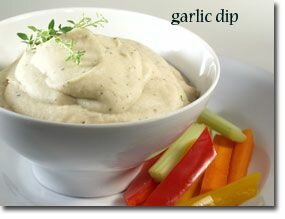July 20, 2013
Check Out What's New On Our Website
Intake
of cantaloupe has recently been found to lower risk of metabolic
syndrome, a group of health problems that includes high blood fats, high
blood sugars, high blood pressure and too much body fat ... For more
see What's New and Beneficial about Cantaloupe.
Today's Recipe
If you don't know what to serve for dinner tonight ...
For a great appetizer before dinner or as a snack any time of the
day, try this quick and easy-to-make dip that goes with any type of
fresh cut vegetables (such as carrots, celery, cucumbers, or bell
peppers. Vegetable appetizers are a great way to curb your appetite
before a meal.
Garlic Dip with Crudités

Prep and Cook Time: 5 minutes
Ingredients:
- 2 cups cooked or canned garbanzo beans (no BPA)
- 1 TBS fresh lemon juice
- 3 cloves garlic, chopped
- 1/4 cup chicken or vegetable broth
- 3 TBS extra virgin olive oil
- Sea salt and pepper to taste
- Combine all ingredients in a blender and blend until smooth.
Serves 8
Printer Friendly Version of Garlic Dip with Crudités
In-Depth Nutritional Profile for Garlic Dip with Crudités
Healthy Food Tip
Can too much fruit cause weight gain?
Can too much fruit cause weight gain?
Yes, too much fruit can cause weight gain. Too much intake of any food can cause weight gain, although some foods are much better to eat in excess than other foods.Fresh fruits contain about 15-20 calories per ounce; for example, a medium-sized apple (weighing about 6 ounces) contains about 100 calories. Most people would be able to include about two times that level of fruit calories in a day of balanced food intake without overeating.
Fruit juice is a little different story because many people could drink one 12-ounce bottle of fruit juice at a single meal and that bottle by itself could contain about 200 calories (in unsweetened form). One bottle per day might work for some weight management plans, but it could also cause problems. This 12-ounce bottle could be too quickly consumed, provide too little satisfaction in terms of texture, chewing, and aroma, and be much less enjoyable overall. In any case, the juice would provide less complete nourishment than the whole fruit.
Dried fruit is the most problematic type of fruit in terms of calories. Six ounces of raisins contain about 500 calories. Most people would not be able to successfully fit this many calories of fruit into their Healthiest Way of Eating.
Weight gain occurs when a person consumes more calories than he or she expends. Therefore, let's say, hypothetically, that based upon your individual energy needs, you need to consume 2,000 calories to maintain your weight. If, in addition to your regular 2,000 calories, you ate 500 additional calories worth of fruit each day, in one week you would gain one pound. (One pound is roughly equal to 3,500 calories of excess energy stored up in the form of body fat.)
In general, although I encourage daily intake of fresh fruit as part of a Healthiest Way of Eating, it's much easier to "overdose" on fruits rather than vegetables when it comes to weight management and maintenance of an optimally nourishing diet. Vegetables generally contain about 5-10 calories per ounce—about half the calories of fruit. Always remember, however, that it's your overall eating plan and exercise plan that determines whether you'll gain or lose weight.


No comments:
Post a Comment